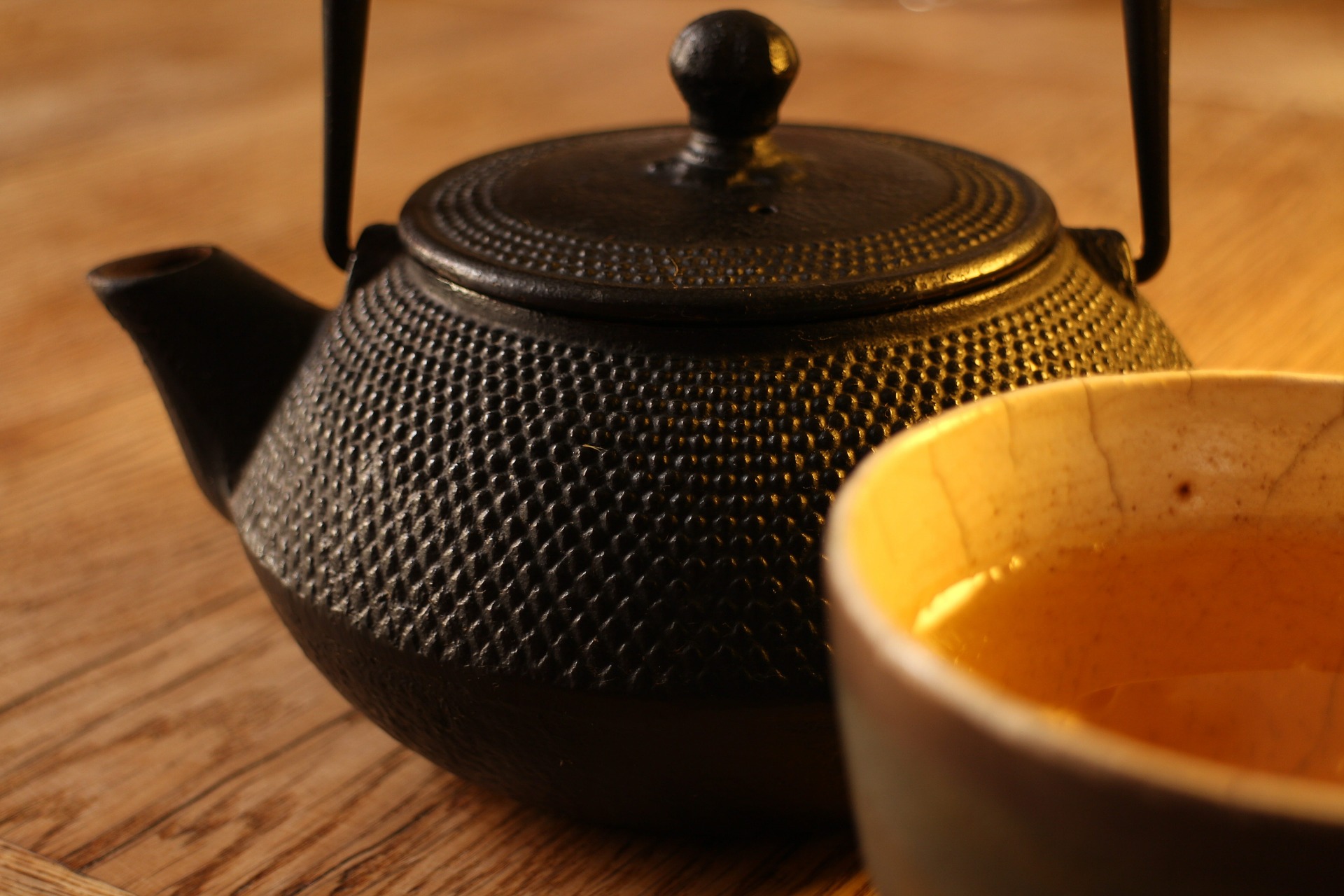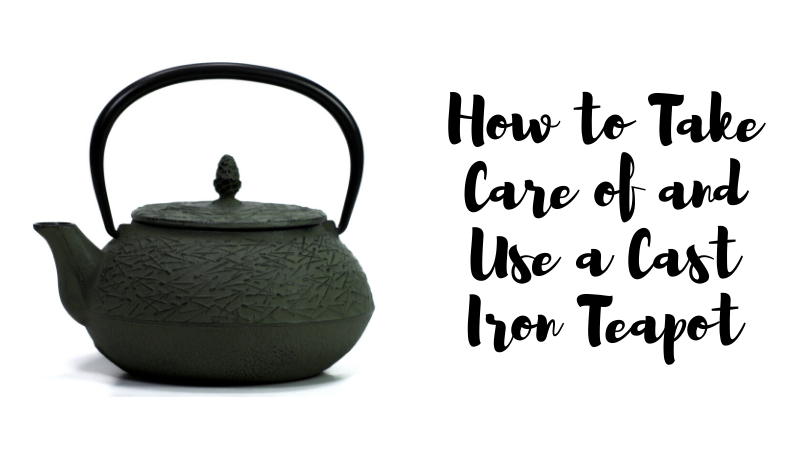Cast iron teapots are a beautiful way to prepare tea. but it is important to know how to properly use and care for them. Here are some tips and tricks to make sure that you will have years of brewing tea together.
Why use a cast iron teapot?
The main advantage of using a cast iron teapot is heat retention. Many people also enjoy the durability of this material. It won’t shatter the way that glass or clay would. As a former Teavana employee, I do have to tell you that most of the pitches that they used to sell them were not accurate. Cast iron teapots do not add iron to the water. They do not absorb or build up nutrients with use. They also do not distribute the heat better than other materials.

Before Use
Cast iron teapots can be used in the same way that you would any other teapot. Most of them come with stainless steel infuser baskets, making it easy to remove the tea leaves. The one important thing to keep in mind is that you should preheat your cast iron teapot with hot water before you start brewing your tea. This makes a huge difference when it comes to the pot’s ability to keep the tea hot. A cold teapot will absorb the heat from the tea if you start brewing without preheating first.
After Use
Cast iron teapots require a little bit of extra maintenance but don’t let that scare you. Just make sure that you clean it right away once you are done drinking. Hand-wash only! Never put cast iron teapots in the dishwasher. Similarly to clay teapots, avoid using detergents or soap. Hot water will usually be enough to rinse away any tea residue. Use a soft cloth to scrub any stubborn stains. I recommend inverting your pot on top of a towel and allowing it to air dry completely before putting it away.
Is it a teapot or kettle?
Cast iron teapots are inspired by and modeled after tetsubin. They are kettles traditionally used to heat water for the Japanese tea ceremony. This leads to a lot of confusion about whether or not your teapot can be used on an open flame or heat source. Tetsubin are used for boiling water but never for actually brewing the tea. If you are looking to purchase an authentic tetsubin, I recommend checking out Artistic Nippon.
If your teapot is lined with enamel, it CAN NOT be used on a heat source any hotter than a tea light candle warmer. Doing so could damage the lining or even cause the pot itself to crack. That is the tea equivalent of using metal utensils on a nonstick frying pan. Just don’t do it!

What if it has rust?
If you discover rust on your teapot clean the area with a soft brush (toothbrushes work well for this). According to The Republic of Tea, allowing spent leaves and water to soak in it afterward will help prevent the spot from rusting again. If the enamel lining is cracked or flaking off, you should stop using the teapot.
Taking proper care of your cast iron teapot will give you years of tea brewing. I bought mine from a Japanese grocery store over ten years ago and it is still in great shape. It doesn’t get used often now that gongfu is my preference but I enjoy making comforting, easy-drinking teas like hojicha in it.
Do you have a cast iron teapot? What teas do you like to brew in it? Tell me in the comments below!
Pin It For Later!


Just wondering how long is too long when leaving tea in my pot? I bought a 40 oz pot and want to enjoy my tea over a few hours. Is that too long?
A few hours should be fine. I would definitely avoid letting them sit overnight, though.
Hi Nicole,
Thanks for this informative video. I have a Kafuh cast iron tea pot that I love. The enamel inside the spout only is peeling. The enamel in the rest of the tea pot is unbroken. So my tea is coming into contact with the broken enamel spout only when poured. Is it unsafe for me to use this tea pot?
If the enamel is peeling it may be compromised. To be on the safe side, I would contact the manufacturer. They would best be able to tell you if it is still safe.
Hello,
I recently bought a cast iron tea pot and it cam with some directions saying to cure the teapot with lemon slices, a tea bag, or loose tea leaves and to put over medium lame. The directions also consistently talk about putting the tea pot over medium flame, but these instructions worry me because the inside is layered with enamel like u said in your video. Do you think this teapot is compromised? or that I got scammed? Also is there a need to do something like curing the teapot before use? Thank you for your time!
That’s unusual. I’ve never seen a teapot have any directions about curing with lemon. If the inside of your teapot is glazed it should never be put on a flame. As long as there are no chips or scorch marks you should be ok going forward. You don’t need to do anything to prepare a teapot for use beyond giving it a good rinse.
Dear Nicole, I have been so thrilled to use a one person Iwachu teapot. I have been so careful with it. It’s lined with enamel and outside is the cast iron. I noticed when I dried it today well that the inner rim on the pot not lid is chipped, and two slivers came off on a paper towel. I am shocked. I have been so careful and dont slam the lid down. This won’t affect the tea and still use of it correct? It’s not perfect now. Bought a few mo ago in a furniture store and ,,,they don’t know about these pots.
Just wondered if I ruined it . No way to sand the rough places down ? It’s the cast iron chipped not the enamel. And lods fine. Thanks for your help. Have you heard of this before,,,that the cast Iron is that fragile? This one has brown lines and brown in color, and I love it, warmly, sally webb
I just got an enamel lined cast iron teapot online and it has this weird looking part inside. It doesn’t look like it has any edges like if it were peeling, it just looks like a discolored rough spot. Is this safe? I’d attach a picture if I could.
I have a cast iron tea pot, pretty sure it has an enamel interior, it’s a Joyce Chen, have had it for close to 20 years. I’ve always just rinsed it and let it air dry, however at some point many years ago, the interior became coated in a build up of I-don’t-know-what… Occasionally I’ll use a bottle brush to scrub the spout so that it pours better, and I’ll also use a soft cloth to try to rub the build up off, but it doesn’t really work.
Any thoughts, suggestions, advice?
It sounds like it could be build up of minerals or tannins. Descaler should be able to remove it (I found a great one in the coffee section of my grocery store). Just make sure to rinse very well afterwards.